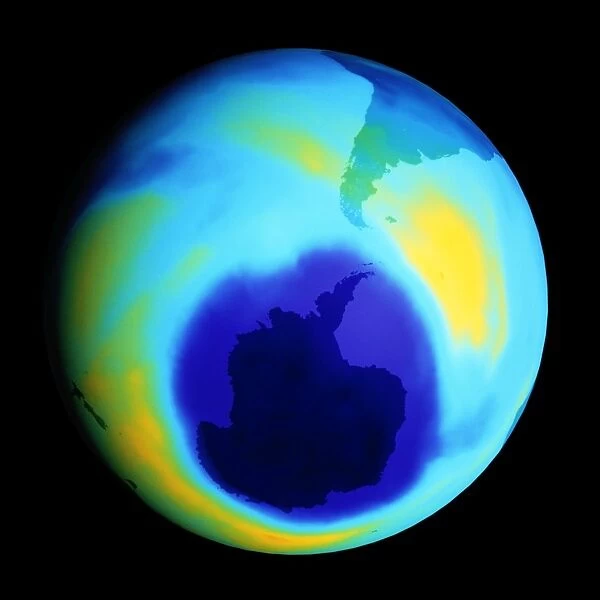Home > Science > Space Exploration > Satellite Imagery
Ozone hole, September 2001
![]()

Wall Art and Photo Gifts from Science Photo Library
Ozone hole, September 2001
Antarctic ozone hole. Coloured satellite image of reduced atmospheric ozone levels around Antarctica (lower centre, darkest blue) on 17 September 2001. The ozone hole (dark blue) is at an annual maximum area (26 million square kilometres that year). The ozone levels are colour-coded, ranging from dark blue (low) through light blue and green to yellow (high). Ozone (O3) absorbs dangerous ultraviolet radiation from the Sun. Atmospheric pollution by chlorofluorocarbons (CFCs) and similar compounds reduces ozone levels. The maximal ozone hole size, similar to the 3 previous years, is predicted to slowly decline over future years. Data from the TOMS (Total Ozone Mapping Spectrometer) sensor
Science Photo Library features Science and Medical images including photos and illustrations
Media ID 6375483
© NASA/SCIENCE PHOTO LIBRARY
2001 Antarctic Antarctica Atmosphere Atmospheric Cfcs Circle Circular Computer Damage Damaged Earth Science Environmental From Space Hemisphere Image Imagery Loss Maximum New Zealand Ozone Hole Peak Polar Polluted Pollution Round Rounded Satellite Sciences South America South Pole Stratosphere Stratospheric Total Ultraviolet Light 17 September Depletion Toms
EDITORS COMMENTS
This print captures the devastating reality of the ozone hole over Antarctica in September 2001. The image, taken by a satellite, reveals a strikingly dark blue area at the lower center, representing the annual maximum extent of this environmental phenomenon. Spanning an immense 26 million square kilometers that year, the ozone hole is clearly visible as it engulfs the polar region. The varying colors in this image indicate different levels of atmospheric ozone concentration. Ranging from low (dark blue) to high (yellow), these color codes demonstrate how chlorofluorocarbons and similar pollutants have contributed to reducing ozone levels. Ozone plays a crucial role in absorbing harmful ultraviolet radiation emitted by the Sun, making its depletion a matter of grave concern for our planet's well-being. Scientists predict that although this year's maximum size resembles those of previous years, gradual decline can be expected in future measurements. This hopeful prospect suggests potential recovery efforts may yield positive results over time. This photograph serves as a powerful reminder of humanity's impact on Earth's delicate ecosystems and highlights the urgent need for global action against pollution and climate change. It stands as both an alarming testament to environmental damage caused by human activity and an inspiration for continued research and innovation aimed at preserving our precious planet for generations to come.
MADE IN AUSTRALIA
Safe Shipping with 30 Day Money Back Guarantee
FREE PERSONALISATION*
We are proud to offer a range of customisation features including Personalised Captions, Color Filters and Picture Zoom Tools
SECURE PAYMENTS
We happily accept a wide range of payment options so you can pay for the things you need in the way that is most convenient for you
* Options may vary by product and licensing agreement. Zoomed Pictures can be adjusted in the Cart.

